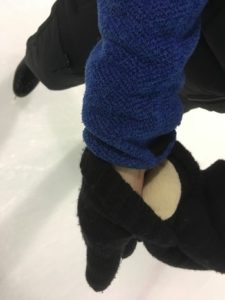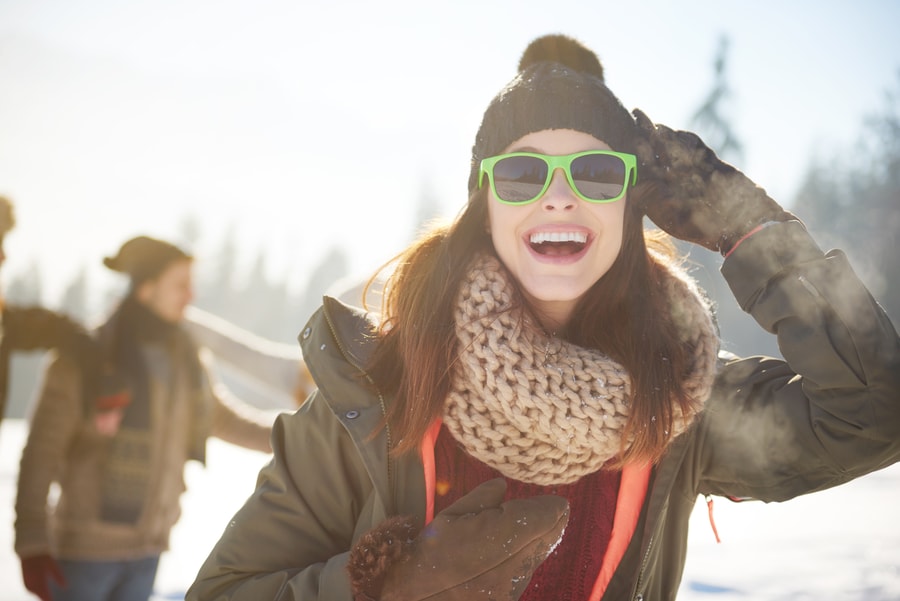If it is your first time ice skating, or if you are a seasoned professional, there are a load of options out there for you. I have taken my experience combined with weeks of research to bring you the ultimate guide on what to wear for ice skating.
Wear clothing that enables you to stretch and to move freely. Consider that your body is the most important part to keep warm, but that extremities will feel the cold even more. Take gloves for warmth and fall protection. Socks will prevent your ice skates from rubbing and will keep your feet warm. A hat will make your head feel more comfortable and stop the cold biting at your ears. Consider layering, so that you can peel off layers as you get warmer and then put them back on as you cool down.
Best clothing for novices or first timers
If you are going ice skating for the first time, well done! Welcome to the world of ice skating.
- My advice is wrap up warm. That sounds obvious I know, but the reason I say that, is because you may not be moving at great speed. Well hopefully not, unless something’s gone terribly wrong. But seriously, you won’t be moving around fast, so you won’t have the heat caused by high levels of cardiovascular exercise, so wrap up. Wear plenty of layers, that’s true for all skaters, Layering up, gives you the option of shedding layers when you get warm.
- Take some gloves (checkout our ultimate gloves for ice skaters here, we have trialed them and created a list of the best). Wearing gloves will keep your hands warm and will offer protection should you fall.
- If you do take a scarf, tuck it in. If it gets caught under your ice skating blade, it will stop it dead and you will go ‘over the handlebars’ so to speak.
- Wear something flexible and warm on your bottom half. Stay away from tight denim jeans as they can be hard to move in. Don’t wear shorts.
- Socks, wear them! For several reasons; 1, they will stop your skates rubbing, 2, if you are hiring skates, you don’t really want your bare feet next to skates that hundreds of people have worn.
- Considering giving very small children a helmet may be a good idea. Very young children aren’t that stable on their feet anyway, they may fall allot on ice. You could try cycling or skiing helmets. Not only will they help in the event of a fall, but they will help keep their head warm.
- Phones and keys. Don’t put them in a pocket where you are going to fall on them. You could break them and more importantly, they could break you!

For skaters who train regularly.
Gloves for regular training
I think it’s worth spending a bit of time finding the right pair of gloves for regular training. Sure you could buy a standard pair of knitted gloves, but if you wearing them 2, 3, 4 or more days a week training, it’s worth getting a pair that you like. A pair that are comfortable and are suitable for your type of training. We have taken a great deal of time, trialing, trying on and researching the best gloves for regular training, so you don’t have to. Before you decide to invest in a decent pair of gloves for regular training, check out our guide to regular training gloves here.
Gloves for ice dancers, synchro and pairs
If you are an ice dancer, synchro or pairs skater get a fitted pair of gloves. By ‘fitted’, I mean a pair that fits closely to your fingers. If you are going to be spending a lot of time in hold, going into and out of different holds, you will need dexterity in your fingers. If you can get some with a degree of elasticity, that will help with a good fit and will also be warm. It is a good idea to get gloves with some kind of grips on. They are usually silicone and really quite ‘grippy’. The gloves with grips on will help if you are rotating around each other at speed in hold or doing lifts. It will also help with your frame. Your hand doesn’t have to slip much to ruin the hold. For a list of tried and tested gloves for figure skaters in regular training click here, you will be amazed at the difference with a professional glove.

Gloves for when it gets really cold.
You don’t have to spend loads of money to get a warm pair of gloves for when the weather gets cold. A pair of woolen gloves with a thinsulate lining will be low cost and very warm. The key is the thinsulate lining. It is a common fabric now, so there are plenty of low cost options of knitted gloves with the thinsulate lining.

Bruceriver Women Snowflake Knit Mittens with Warm Thinsulate Fleece Lining (Link to Amazon – Commissions earned)
Mittens – for when it gets really really cold.
Yes, when its really cold, there are few things warmer than mittens. Mittens are so warm because they hold all of your fingers together. There is an added bonus, that if you use heat packs with mittens, the heat pack slides right down to your fingers. There are downsides, like the lack of dexterity. If you aren’t doing anything too complex in hold however or are a solo skater, mittens can be a good choice when it gets really cold. The above shown Bruceriver mittens are knitted with a fleece lining, they are a relatively low cost solution, check them out at Amazon here. (Link to Amazon – Commissions earned)
Its all about the layering!
For most training situations, a fitted tight yet flexible top is the best first layer. Often technical fabrics that offer breath ability are best. There are many technical tops on the market from major sports retailers. They don’t necessarily have to be skating specific. In the absence of a technical top, then a fitted long sleeve t shirt will work well. Your second layer is a fitted fleece. Clothing manufacturers know these as a mid layer. Make sure that the mid layer is flexible and is cut in a way that offers you a full range of movement. As you get warmer through your training session, you can take off the mid layer and train in the base layer. In the winter I also wear a t shirt over the base layer and underneath the mid layer.
Are gilets/body warmers any good for ice skating?
Yes, in a word, they are excellent. The great thing about gilet’s is that they keep your body warm without restricting any of your movement. I wear a gilet over the top of my base layer. I wear it on the way to the rink, whilst I do my warm up run and then for my warm up on ice. It then take it off later in the training session.


What are the best gilets to wear for ice skating.
Fairly close fitting gilets tend to be better. They don’t restrict your arms, so you might as well get one that fits reasonably close to your body. Don’t go to the extreme, you do need to be able to move, but you don’t want it flapping around, because the wind will get under it and you will lose all the heat. At the same time gillets do tend to be made out of slippy material so if your training with a partner, bear that in mind, in terms of grip. You can always take it off for the part of your training where you need the grip though. The above men’s gilet, is down filled, which is famous for its light weight and warmth, check it out at Amazon here. (Link to Amazon – Commissions earned)
Or for ladies, the above Mountain Warehouse Crescent Womens Down Gilet – Winter Body Warmer. (Link to Amazon – Commissions earned)

Skating shorts
Skating shorts are manufactured from the same materials that the skating leggings. These are often worn with skating tights. These can be of benefit when skating in the summer when the ice rink is warmer than usual. Check out this 3 pack of shorts at a very reasonable price at Amazon. (Link to Amazon – Commissions earned)
Skating tights/pantyhose
When purchasing skating tights, it’s best to opt for pairs that are specifically designed for ice skating. Which ever variety of specialized skating tights you purchase, you will notice that they cost considerably more than ordinary tights. This is because they are higher quality with a stronger construction. Although prices do vary among brand, design and quality.
Ice skating tights come in three shape varieties. There is the kind that are wider at the foot end and are open so that they cover the boot. In this type, there are elasticated bottoms, or bottoms with a fixing. When purchasing the ones with a fixing, the choice is often a press stud or a hook and eye. It is better to opt for the hook and eye design as a choice of fixing, as the press stud ones often come undone.

The second type is the tights that go inside the boot. Purchasing this design is a matter of personal preference and requirements for your skating.

The third type has a wide open foot and fits partially over the skate, again, this is a matter of personal preference.

There are two distinct types of skating tights. There are training tights and competition tights. Though when purchasing them, it may not always be obvious which are which, as they aren’t always marked up as training or competition tights.
Training tights are thicker and more durable than competition tights. They are warmer and usually opaque, with a high denier rating. They tend to have a matt finish.
Competition tights are thinner, with a lower denier rating. They are slightly transparent being sheer and are designed to be more aesthetically pleasing. They are often available with a and shiny finish.
Skating tights have the added bonus of the ability to wear them under leggings when it is very cold.
Bottoms or leggings
The best thing to wear on your bottom half, I will split into two sections; women and men.
First, the best bottoms for women:
It’s important to go for something flexible and warm here. For women that usually means leggings. A decent set of warm leggings will stand you in good stead in the absence of proper skating leggings/pants. Choose ones that are reasonably thick and that have a good amount of stretch to them.
An ideal situation is to have professional skating leggings or pants in the U.S.A. Proper skating bottoms are much warmer than traditional leggings or stretch fit pants. Yes they cost more. But that is because they generally have a lot more manufacturing in them. That is usually because they are well made, warm and often have both a degree of water resistance and breathability. Skating leggings tend to be a bit thicker than regular leggings/stretch pants. They are manufactured longer than regular leggings, this means that they can go over the top of you ice skates and reach down to your heal. Some are also made with clips that can attach each other or your skates, to keep them covering the top of your ice skating boot without riding up. They are more expensive, but they last, they are comfortable and warm. Professional ice skating bottoms are available in loads of different colours and look great.

Now men:
For men, there are three options:
- Before I had all the proper gear, I wore jogging bottoms/tracksuit bottoms, whatever you want to call them. I went for the fleecy ones, as these were warmer than others. I opted for the open leg ones, not the elasticated ankle ones, as these sit over your ice skates and look a bit odd. But when you are just starting out, tracksuit bottoms are a great alternative to jeans. Unlike jeans they are flexible and warm. When you start to skate a little more often however, opt for one of the following options:
- For everyday training, I always go for a professional walking trouser. These are the kind that are marketed towards walkers and outdoor pursuits. They are great because they have a degree of elasticity in them, that allows you to move through a full range of motion. They are often water resistant, designed for the outdoors, to be at least shower resistant. Generally they tend to have wind stopping properties, which is great when you are cold and gathering speed over the ice. Not having the wind going through your clothes is a big help. Generally available in dark colours, they look smart, more than jogging bottoms at least. Best part of all of this, they are pretty inexpensive. You don’t need to pay much for a pair that can last you years.

- The other option, is professional skating trousers for men. These tend to be worn for competition, they have a large amount of elastane type material in them and tend to fasten under the boot. They look smart for competitions, but are a bit over the top for me every day training. When you need to look the part however, professional skating trousers might be for you. They tend to be more expensive than some of the other options mentioned, but like so many things, you get what you pay for.

Tops/sweaters and hoodies
There are many things you can put on the top half of your body when ice skating. Personally me and my skating partner have tried just about all of them. Here is a quick guide to keeping your upper half warm and comfy whilst ice skating.
- The full zip fronted technical mid layer top with no hood. I have put this first, because, if you own nothing else for your top half, this is the thing to own. Technical fabrics are breathable and if you shop well, flexible. Tight fitting to your body, they don’t get in the way and show good lines for coaches to observe. They are hard wearing and will take a daily punishing. They are not cheap, but worth the investment in the long run. The full zip makes it easy to remove if you do get a little warm. They also have the added ability to make you look the part. You definitely look more like s serious ice skater. But it’s not all about the looks. A decent technical top will keep you warm when you are cold and wick away sweat when you are getting hotter. That goes for men and women. There are technical mid layers for both men and women that look great. They are available in a never ending range of designs and colours, so you are sure to find one that suits you.
- The ¼ zip technical sweater. These are good, especially the technical fabric. These tend to be a lower cost than the full zip version. The only issue with these is, that if you do get a bit warm then they are more difficult to take off than the full zip. They are however, the next logical step for people that are making a move into their first technical top after moving from a regular sweater.
- Jumpers and sweaters. Yes you can wear these. If you do, try to wear something that is either loose or has so elastic property. Whilst not as good as the technical mid layer, when starting out, they can be a good option, especially as most people already have something available in their own wardrobe.
- Hoodies, well, if you have nothing else then go for it, better than being cold. The trouble is that the hood is surplus to requirement really and tends to flap around and get in the way. So if you have any of the above, maybe go for that.
Hats
A hat is a great piece of kit when training on cold mornings. Both men and women often wear knitted beanie type hats whilst training. Almost anything goes here. Colors, designs and knits vary. The best tip here is to wear something that is comfortable, something that you are going to forget that you are wearing after a few minutes of training. I know many skaters that have quite a collection of knitted hats, one for each day of the week! Choosing a hat that covers your ears is a good idea. One that fitted, but not so tight that you feel uncomfortable once you start to get a bit warmer. For cool conditions, a single layer knitted beanie is great. When it starts to get colder, go for double layered or thicker chunkier knit. When it gets really cold, beanie hats with a thinsulate lining are great.
Jackets
If you are training regularly, you probably won’t be wearing a jacket for most of it. However, if you have ever been at an ice rink at 6 am in the winter, you know, it can be mighty cold. A jacket is great for the trip to the rink, whist you are getting your skates on and on ice until you start to feel warmer and can start peeling off layers. There are plenty of great jackets out there to wear to the rink, but consider the following points before you purchase:
- Go for a jacket with the right filling. You want it to be light. A down fill is light and really warm. An animal friendly version could be an artificial down or poly fill.
- Don’t get a jacket that is really long. Don’t forget, you want to be able to get on the ice and skate in it, so hip length is ideal.
- Check out the technical jackets from outdoors manufacturers, there are some really clever fabrics out there. Some jackets have the ability to keep you warm and lose moisture at the same time as being water resistant.
- Remember that if a jacket stops the wind, it will be warmer than ones that don’t and so may not need as much filling to be just as warm.
- A jacket that allows you to move whilst at the same time is close fitting will offer you the greatest level of warmth whilst skating.
- If you are already wearing a base and a mid layer, you don’t need a really bulky jacket. The layering system is the best way of keeping warm.
- Get a jacket that you like, that way, you can wear it when you are off ice too.
Base layers
For women a vest top when its warm with a mid-layer over the top, when it gets cooler, a long sleeve T shirt under a mid-layer.
For the first layer, for men, personally I go for a long sleeved cotton T shirt, then I put a regular T shirt over the top. This works for most skating scenarios and is plenty warm enough with a mid layer on and a gilet.
When it gets cold, for both men and women, It’s better to opt for a technical thermal fabric that is close to the skin and can wick away and evaporate off sweat when you start getting hot. In the coldest parts of winter, I opt for a technical thermal compression layer with a flocked/fleece lining.
Similarly, when it is warmer or, when you are training hard, a technical base layer designed to keep you cool, will help wick away moisture from your skin and keep you comfortable and dry.
Like most technical fabrics, they tend to be more expensive, but they last a long time and wash well.

Socks
When it comes to socks, personally, both me and my ice dance partner, keep it simple. Normal cotton socks. They are great because they are not so thick that you can’t feel what your feet are doing in the skates and not so thin that your boots rub in places.

